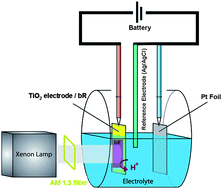In recent years, considerable efforts have been made to improve the performance of photoactive nanostructured materials for water splitting applications. Herein, we report on the assembly and use of a bacteriorhodopsin (bR)/TiO2 nanotube array hybrid electrode system. Photoanode materials composed of ∼ 7μm long self-ordered and vertically oriented nanotube array of titanium dioxide films were fabricated via the anodization of Ti foil in formamide electrolytes containing NH4F at room temperature followed by sensitization of the electrodes with bR. The stability of bR on the TiO2 surface was found to depend on the pretreatment process of the TiO2 films. Our results demonstrate the opportunity to fabricate fairly stable bR/TiO2 hybrid electrodes that can be used as photoanodes for photoelectrochemical water splitting. Under AM 1.5 illumination (100 mW/cm2), the hybrid electrodes achieved a photocurrent density of 0.65 mA/cm2 which is a ∼ 50% increase over that measured for pure TiO2 nanotubes (0.43 mA/cm2) fabricated and tested under the same conditions. In the presence of a redox electrolyte, the photocurrent increased to 0.87 mA/cm2. To the best of our knowledge, this is the first report on the use of bR/TiO2 hybrid electrodes in photoelectrochemical water oxidation cells. We believe the proton pumping property of bR can be used in a variety of applications, especially those related to third generation photovoltaic cells.

You have access to this article
 Please wait while we load your content...
Something went wrong. Try again?
Please wait while we load your content...
Something went wrong. Try again?


 Please wait while we load your content...
Please wait while we load your content...